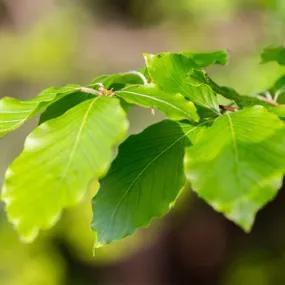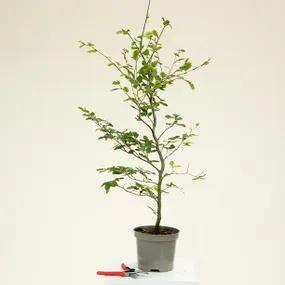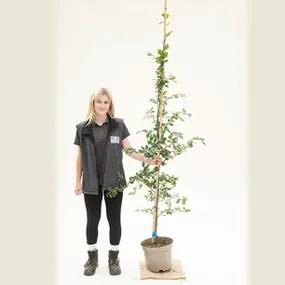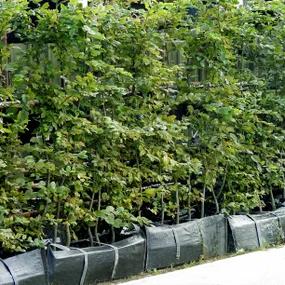Green Beech Hedging Plants

The details
Fagus sylvatica
Hedge Plants- Hedge: 1m to very tall
- Soil: Any fertile & well drained.
- Use: Formal/Native
- Single Row: 3/m
- Colour: green/brown
- Great to add structure
- RHS Award of Garden Merit
Recommended extras
Description
Fagus sylvatica: Bareroot Green Beech Hedge Plants
Delivered by Mail Order Direct from our Nursery with a Year Guarantee
Green Beech is superb as hedging. In spring, its graceful branches are clothed with bright, green leaves with a wisp of furriness to them that disappears as the foliage matures to a more intense green, finally becoming golden and russet-coloured in the autumn. The summer brings tiny flowers that mature into beech nuts in the autumn. The bark is smooth and grey, the colour of elephant hide - very Farrow and Ball.
You can see our copper beech hedging plants, or buy beech trees in large standard sizes.
As a well-clipped hedge, you get the changing foliage colours from spring to autumn, and then it will hold onto its desiccated leaves through the winter (known as marcescence), giving you the privacy of an evergreen hedge but with the lightness of colour and tone of a deciduous hedge.
As a tree, it can reach 35 metres.
Delivery season: Beech plants are delivered bareroot during late autumn and winter, approximately November-March inclusive.
Choosing a size: Small plants are cheaper and overall better for hedge use, unless instant impact is your priority. If you are only buying a few plants for ornamental use, then you may as well use bigger ones. All our hedge plants are measured by their height in centimetres above the ground (the roots aren't measured).
What is a trough?
A trough contains 5 beech, and is better value than buying 5 potted beech of the same size.
The trough keeps the beech growing together in a nice row, it's easy to carry and remove, and the ready-made section of hedge should be planting directly into well-prepared soil, and watered very well so that the water has time to penetrate the large block of potting soil.
Features
- Size sold: 40-175 cm
- Hedge height: 1m to very tall
- Soil: all soils, but not badly drained
- Use: Formal/Native
- Single Row: 3/m (no need for a double row unless you want a stock-proof hedge
- Colour: green in spring, golden-brown in autumn
- Great to add structure & value to your property.
- RHS Award of Garden Merit
Growing Common Beech
Beech is fairly unfussy about where it is planted but does not like very heavy, wet soils, winter waterlogging, or deep a shade: if you have those, hornbeam is a close alternative.
Well-drained, rich soil in a sunny position is perfect, not least because it is glorious to see the sun shining through its translucent green leaves in spring.
It is easily clipped to shape and only requires yearly pruning making it low maintenance once established.
It rarely succumbs to disease: when it does, it is usually tar crust, which typically affects old trees, not hedges.
Spacing a Beech hedge: Like most formal hedging, plant at 3 per metre, 33cm apart in a single row or for 2 staggered rows, 3 plants per metre and with 40 cm between rows
Green Beech in your Garden
Along with Yew, Beech is a go-to hedge for increasing the value of your property, and is probably the most popular deciduous hedge in the UK today.
A space enclosed by beech has a weightlessness to it that cannot be achieved by the more sombre dark colours of evergreen hedging. A beech hedge will provide 'bones' for your garden year round so that you can divide your garden into rooms, or just create an elegant boundary with your neighbour.
A clipped beech hedge is a tremendous backdrop to a herbaceous border, providing a contrast to the colour of the flowers and a flat background to set off the architectural shapes of plants like Acanthus or any dark, evergreen topiary.
One planting idea is to grow a pretty Ivy such as Glacier or Gold Heart under the hedge, which smothers the weeds and frames its base nicely. On a slightly grander scale, statues looks wonderful against a beech hedge: stand a stone or lead urn, planter or figure against it and immediately your garden will look more sophisticated and complete.
Once a hedge is well-established you can experiment with cutting niches into it to contain statues or sculptures. To add drama, intersperse some copper beech amongst the green (or go the whole hog and just plant a copper beech hedge).
Did You Know?
Is Beech really native to Britain?
While no one knows for sure, beech has been part of our landscape for at least 5-6000 thousand years, and might well be native to Southern England.
What is the biggest beech hedge in the world?
The tallest and longest hedge in the world, as recognised by the Guinness Book of Records, is the Meikleour green beech hedge in North East Scotland. It is 30m tall and 530m long.
It was planted in late 1745 by local men before they marched to fight in the Jacobite rebellion. They were mostly killed the following Spring at the Battle of Culloden, and so the hedge was allowed to reach such a fantastic height in their memory (and because it provides a fantastic windbreak, but let's not spoil the story here).
Are beech nuts (mast) edible?
The nuts, called beechmast, are edible in small quantities, but the taste is not great: think of them like natural vitamin tablets, and try eating one or two a day.
People used to make a flour from them and soak it to leach out the bitter tannins, making it possible to eat them in quantity.
Pig farmers used to fatten their livestock on beechnuts over winter, a practice reflected in Spain where pigs are fed on acorns: the resulting Jamon Iberico is some of the most expensive in the world.
What is Beech wood used for?
Beech wood is hard, but not rot resistant enough for outdoor structures, so it is used for a wide range of indoor purposes, from furniture and floorboards to musical instruments, tool handles, and plywood.
It makes great firewood:
"Beechwood fires are bright and clear
If the logs are kept a year"
Planting Instructions
Growing Green Beech plants:
Fagus sylvatica grows in any well-drained soil and it is good in the wind. So it is ideal for planting on the tops of banks where it loves the drainage. If it takes more than a day for surface water to drain away after heavy rains, then your soil is probably too heavy for Beech in which case Hornbeam is a good alternative, as it looks similar and like beech it holds its leaves in winter.
Prepare your site before planting:
It is best to dig over the area where you plant a hedge in advance, especially if the soil is poor. Kill the weeds then dig the soil over; removing rocks, roots and other rubbish. Mix in a little well-rotted compost or manure to improve the soil if it needs it.
One of the most important things to ensure is that your beech saplings are not competing with lots of weeds. They will grow away exponentially if kept weed free and watered well.
Watch our video on how to plant a formal hedge for full details. The plants in this video are delivered pot-grown, but planting out bareroot stock is essentially the same.
Remember to water establishing plants during dry weather for at least a year after planting.
Hedge Planting Accessories:
Always use Rootgrow - it really makes a difference to establishment and growth.
After you plant a beech hedge, the most important thing to do is water it in dry weather and keep it clear of weeds. Both of these will be necessary for at least a year after planting.
These instructions apply to all sizes of beech hedge plants and are the same as for any formal hedging, whether it is bareroot or potgrown (as opposed to country hedging). For pictures, please watch our formal hedge planting video.
Beech is best planted at 3 plants per metre, one every 33cms, in a single row to allow sufficient room for the roots to establish, but close enough for a tightly knit hedge to grow quickly.
For a stock proof hedge, you would need to plant in a staggered double row, with the rows 40cm apart. The plants are still 33cms apart along each row, and the rows are offset from each other by 16-17cm, so that from a bird's eye view, any 5 plants would make a "W" if they were joined up. You will need to allow 5 trees per metre.
A Beech hedge can last hundreds of years so it is important that you prepare the site thoroughly before planting. The single most important thing is that there is no competition for food or water from other flora (weeds, including grass).
Young beech saplings of 40-60 or 60-80cm tall can be slit planted (see below). Prepare the ground by cutting the turf/top layer and laying it to one side, and then rotavating the ground beneath, ready for planting. The turf/top layer can be put back upside down (under a mat if you are using one) or used elsewhere in the garden. This is done using a weed control fabric such as Mypex.
Larger beech from 80cm upwards have roots that are too big for slit planting and will need to be planted in a trench (see below).
Whatever its size, Beech prefers a well-drained soil and hates sticky clay. You can add grit to help with drainage, but if your ground just does not drain well, then plant hornbeam instead.
You can not plant when it is freezing or pouring with rain. If possible, try to avoid planting on a very windy day as roots tend to dry out very quickly then, but if it can't be helped then take extra care to keep the roots wrapped up and moist until they go into the ground. Whichever planting method you use, it is much easier with two or three people.
Slit Planting
This can be done direct into markings the soil, or for ease of maintenance you can plant through Mypex weed supression fabric.
This easy and successful technique even great in windy places. However, it only works with bareroot, smaller plants, graded 60-80cm or shorter. Larger plants need trench planting, see below.
Installing the Mypex:
- Lay the Mypex along the line of the intended hedge. The fabric is just over 100cm wide and you only need a 40+ cm width for a single row of plants (60-70cm for a double row). You can cut it to width and peg it down if you want, but the following is much easier.
- Do not cut it to width just yet. Instead, standing on the Mypex and using an ordinary garden spade simply drive the spade into the soil, through the Mypex, down for about 2-3". Mypex is very strong and tucks firmly into the slit made by the spade.
- Do this all along one edge and then back along the other trying to keep the fabric taut. More people standing on it, or two people working face to face with two spades make the job easier.
- Using a garden line to keep straight, cut slits across the fabric a little longer than your spade is wide. A single row is every 33cm, and a double row is two single rows 40cm apart, staggered or offset by 16.5cm into a zig-zag shape: W
Slit planting:
- Put the spade through the first slit or marking and drive it down vertically to full depth. Push the spade handle forward, and pull it back, making a slot in the ground. Remove the spade.
- Take a sapling from the Rootgrow mixture or bucket of water and hold it above the ground with the roots over and along the line of the slot. Bring the sapling upright "sweeping" the roots down into the slot in the same motion. Hold the plant at about the level it was growing before it was lifted and firm the ground down around it with your bodyweight. The better the contact between earth and root, the better the plant will establish, so it should be hard to pull it out of the ground using just thumb and forefinger.
- Finish the row and water it thoroughly.
- Water really well in dry spells all through the first summer.
Trench Planting
Digging a long trench is hard work without machines! A good trench is 60cm wide, but 45cm is acceptable, and a full spade's depth.
- Remove grass, weeds, roots, large stones, and loosen the bottom of the trench with a garden fork to help drainage.
- Improve most soils by mixing in no more than 25% by volume of well-rotted manure or good garden compost like Rocketgro.
- On heavy clay, add nothing: only break up soil compaction, then apply mulch later, after planting over the soil.
Ideally, do the above in advance, putting the soil back into the trench so it settles before planting (covering it with weed-proof fabric is most convenient)
- On planting day, keep your plants roots protected from wind in their plastic bags. As you need them, take out a bundle at a time, and put their roots directly into your bucket of Rootgrow or water.
- Use a garden line to keep your planting straight and dig a good sized hole every 33cm in your beautifully filled in trench.
- Take a sapling from the bucket, hold it vertically in the trench spreading out its roots so that as much root as possible is in contact with the soil. They should not curl back on themselves!
- Cut off damaged roots with secateurs.
- Check the "tide mark" on the trunk, where the soil level was before the sapling was lifted: it should be the same height in the new soil.
- Mound soil under the roots until you reach the right height. Planting too deeply is a common mistake with planting trees! Most bark rots quite easily, so planting shallow is better than planting deep.
- Backfill around the roots, firming the soil gently as you go to remove air pockets until the soil is at the level of the "tide mark".
- Don't damage the roots by stamping down too hard, only make sure they are securely planted.
- Move on 33cm and repeat the process until all are planted.
- Return along the row treading down the soil so that the roots are well ensconced and check each plant is vertical.
- If you need more support against wind, use 90cm bamboo canes as "stakes", tied low to the trunk of each plant with ordinary garden string. Pull the canes out the following autumn.
- Water well.
- Mulch around the plants and up to 45cm away with well rotted farm manure/compost; do not pile it up against the trunk.
Trim off the leaf bud at the end of every stem, all over the plant, as soon as they are planted. Otherwise do not prune your beech at all until the following spring.
Keep watering your new hedge weekly (unless it was very wet) for its first summer. A leaky pipe along the length of the hedge will save you hours watering.
Aftercare
If your beech was well planted it will only need two things in its early years. Trimming and shaping happens later.
The first is to be kept free of weeds (including grass). Keep bare earth, or organic mulch, or Mypex (covered with bark or gravel if you don't like its look) around your hedge. Nothing green and growing.
The second is to have enough water in its first two years after planting. We cannot overstate this. In our experience, approaching 100% of the beech failures we replace under guarantee died because they were not watered when the weather was dry. Beech is very shallow rooted in the first couple of years after planting.
In year 1 in particular, water your hedge really well in a dry week. If you use Mypex or other mulch, you will need less water, but still water!
Trimming green beech hedge plants:
Green Beech hedging that is planted in winter should be allowed to come into leaf before being trimmed very lightly, just enough to remove the leaves from the ends of each stem. We recommend this more for the larger sizes, over 80-100 cms. If you are using smaller plants, just nip the tops of each plant after they come into leaf. If you are planting a beech hedge in summer, using pot-grown plants, don't trim them at all.
From the winter after planting onwards, your young hedge should be trimmed very lightly once a year, until it is mature.
When it is fully grown, you should clip Green Beech hedging in late summer to make it hold its autumn leaves right through the winter.

 PRODUCT CAT 3.webp)
 PRODUCT CAT 3.webp)

 Hedging Sparrow 2.webp)



